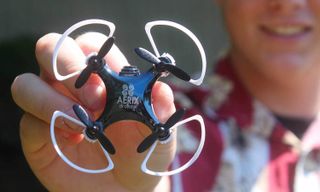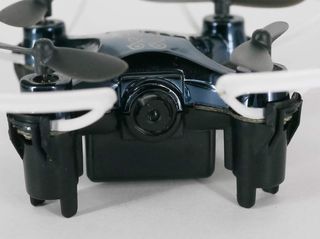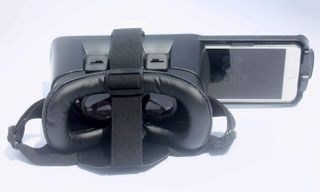Aerix Vidius HD Drone Review: First-Person Views on the Cheap
The Aerix Vidius HD is a cheap, cheerful FPV video drone, but it doesn’t fly that well.
Why you can trust Tom's Guide

There is no shortage of drones that can stream video to your phone, but to really get that in-the-cockpit experience, you need the video to be high definition (HD) and to offer a first-person view (FPV) on a headset. That's what the Vidus HD does; manufacturer Axis Drones claims that this is the smallest and cheapest HD-streaming drone out there, and that with the optional headset, it's a full-FPV drone. Priced at $95 for the drone and $20 for the headset, the Vidius HD mostly meets those claims, but with a few caveats.
Design: Sleek and simple
The Vidius HD is a sleek, small, shiny, black drone, measuring less than 1 inch high and about 3 inches across (including the rotor blade protectors; the drone body is about 1.7 inches wide). The drone weighs less than an ounce, with much of that weight coming from the 200-mAh battery in the bottom of the body. This battery provides about 6 minutes of flight and can't be removed. It can be charged from a USB port with the included cable.

Just above the battery is the tiny lens for the tiny 720p video camera. Four twin-blade rotors, which fit right on top of the tiny motors, lift the Vidius HD. The rotors are easily removed with an included tool.
Specs
Rotors: 4 (2 blades per rotor) replaceable, 1.2-inch diameter
Battery Size: 200-mAh Li-ion, nonremovable
Battery Life: 6/6 minutes (claimed/tested)
Camera: 720p video, 1-megapixel stills
Smartphone Controlled: Yes, over Wi-Fi with free app
FAA Registration: No
Size: 3 by 3 by 1.25 inch (including rotor protectors)
Weight: 0.75 ounces
MORE: Best Drones - Top Rated Quadcopters on the Market
Controller: Small, but well-formed
A little larger than the drone itself, the controller still looks like it was designed for hobbits. Made of white and black plastic, it has two small control sticks, a power switch and two shoulder buttons that trigger the video recording and stunts. The controller feels a little odd because it is so small, but the sticks are comfortable to use.

The video goggles that you wear for FPV flying are larger than the drone and the controller combined. They're designed to hold smartphones, including the large iPhone 7 Plus, in a plastic tray that slides into the front of the goggles, putting it right in front of your eyes. The goggles are large, but not uncomfortable to wear, with soft padding on the side that fits against your face. Forget wearing them with glasses, though; there just isn't room inside for spectacles. Fortunately, you can adjust the focus of each of the eye lenses separately, so most glasses wearers should be able to use the headset.

Don't expect to see anything outside the goggles when wearing them. You can't glance down to see the controller in your hands, so if you slip or aren't sure of the location of buttons, you'll have to remove the goggles to check. If you aren't sure where the drone is, you'll have to lift the goggles up to see. With the somewhat jittery flying of the Vidius HD, this makes the goggles rather frustrating to use.
Aerix offers apps for iOS and Android that connect to the 2.4-GHz Wi-Fi network the drone creates. You can use the app to control the drone via your phone's touch screen, or record and watch the video that the drone sends.
Flying: Mostly smooth
The Vidius HD is pretty simple to get into the air, but harder to keep up there. To take off, you calibrate the drone by putting it on a flat surface and pulling both sticks on the controller to the bottom left. After a couple of bleeps while the drone figures out which way is down, the controller beeps again. Pull the two sticks left/right and down, and the drone starts its motors. A twitch of the left stick then sends the vehicle into the air, hovering a few feet above the ground and ready to maneuver at your command.

The Vidius maneuvers slowly in the default flying mode (called 30 percent), but the 60 percent and 100 percent modes make for a much faster and more maneuverable beast. The drone is very sensitive to light touches on the control sticks in all modes, though. Larger drones use their own weight and size to help fly straight and level, but the Vidius HD doesn't have this built-in stability, so it can be a bumpy ride. However, the drone can hover nicely and be flown straight with practice, and the built-in rotor blade protectors do help the craft survive crashes.
The controller also offers a trick mode: Press the right stick in and flip the stick in any direction, and the Vidius will do a flip or roll in that direction. Don't try this unless you have the drone at least 4 feet off the ground, though; the Vidius takes a bit of time to recover and ends up a couple of feet lower than where it started.
Alternatively, you can fly using the touch-screen controls on the app, which provides two virtual control sticks overlaid on the video preview. This also offers a gyro mode, in which the tip and tilt of the phone itself is used to control the drone.
MORE: Drone Buying Guide: Everything You Need to Know
Finally, an FPV flight mode in the app splits the preview into two smaller screens. Put the phone in the headset, stick it on your head and you are in the pilot's seat, albeit figuratively. You have to use the controller in this mode; there is no way to maneuver from the phone or by shaking your head. While the clear, fairly sharp video preview gives you a good sense of immersion, you have to fly by touch, because you can't see the controller while wearing the headset. That makes precise maneuvering rather difficult.
Photos & Video: Not really HD
The Vidius HD ups the resolution from previous Aerix models, which is definitely welcome, because those drones produced somewhat low-quality, low-resolution video. I found that the Vidius captured decent-quality video at a resolution of 640 x 482 pixels. If that sounds a little less than the HD the name suggests, you are correct. The Vidius HD doesn't actually capture HD video. Instead, the HD part of the name refers to the video preview, which can be viewed at 720p resolution when an option is enabled.
When the drone was still, this extra resolution made the preview and the captured video sharper and more realistic. It's still not broadcast quality, though. The video is rather noisy in anything other than bright light and gets somewhat fuzzy and difficult to follow when the drone is turning or moving fast.
You don't get any stabilization or pan/tilt control, either; the camera captures every shake and bump of the drone, and only points forward. If you fly the drone left or right, the camera tilts along with the drone body as it slips sideways. It's a somewhat disorienting experience for the first-time flier using the FPV headset, and the recorded video captures this bumpy ride. There is also a slight but noticeable lag between the controls and the video, which makes maneuvering close to objects a little difficult; move at anything faster than a crawl, and you'll have hit the object by the time you notice you are getting close.
Repairability: Replaceable rotor blades
Only the rotor blades on the Vidius HD are repairable. You can use an included tool to pop them off and replace them if they get damaged. The blades do pop off a little too easily, though. Despite the guards protecting the blades, I lost a couple of rotors when they flew off in a crash. The Vidius comes with a full set of four rotor blades, and Axis Drones sells a replacement set for $15.
MORE: What the FAA's Drone Rules Mean for You
Battery Life: Short
The small battery in the Vidius HD gives you about 6 minutes of flight time. That's a little frustrating, because it is too short a time to get familiar with the controls and get set up with the goggles. By the time you are set up and ready to go, you've got only a couple of minutes of flight time left. You can't swap out batteries, either; the battery is built into the drone case, and recharging the battery takes about 30 to 40 minutes using the included USB cable.
Bottom Line
The Vidius HD is a good value for the money, as long as you don't expect too much. Like most small drones, it isn't easy to fly, as it tilts and flies off easily and is buffeted by even slight breezes. The FPV headset definitely adds a new angle to flying the drone, and the Vidius HD is by far the least-expensive drone to offer this feature—all other drones with similar features cost at least twice as much. But the headset's face-covering design means that it is rather hard to control the drone with the headset on, and the short battery life doesn't give you much time to practice.
Still, despite these limitations, the Vidius HD is a nice way to get a feel for the fun of FPV drone flying.
Sign up to get the BEST of Tom’s Guide direct to your inbox.
Upgrade your life with a daily dose of the biggest tech news, lifestyle hacks and our curated analysis. Be the first to know about cutting-edge gadgets and the hottest deals.
Richard Baguley has been working as a technology writer and journalist since 1993. As well as contributing to Tom's Guide, he writes for Cnet, T3, Wired and many other publications.
